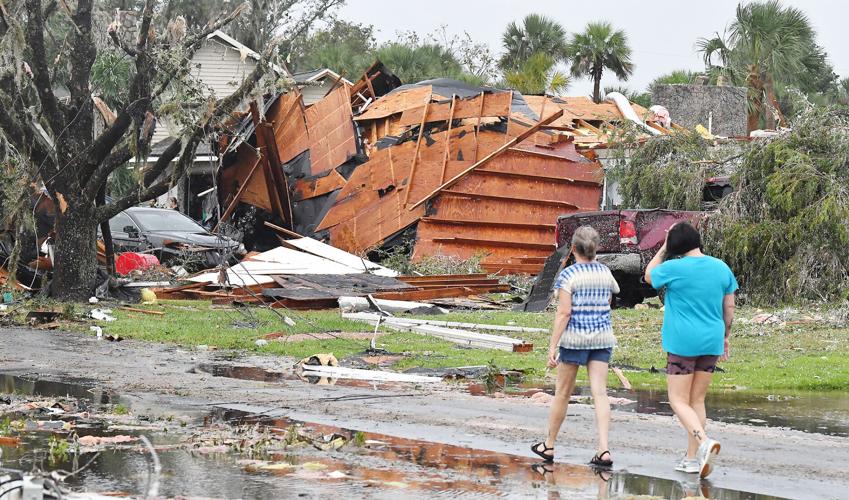Historical Context and Impact

Crystal river tornado – On the fateful afternoon of March 8, 1998, a violent tornado touched down in Crystal River, Florida, leaving a trail of devastation in its wake. The twister, classified as an F4 on the Fujita scale, was the culmination of a severe weather system that had swept across the southeastern United States.
Formation and Path
The Crystal River tornado originated as a supercell thunderstorm over the Gulf of Mexico. As it moved inland, it rapidly intensified, gaining strength from the warm, moist air and unstable atmospheric conditions. The tornado first struck Crystal River at approximately 4:30 PM, carving a path of destruction that stretched for nearly 10 miles.
Impact on the Community
The tornado caused widespread damage to the Crystal River community. Hundreds of homes and businesses were destroyed or severely damaged, leaving many residents homeless. The tornado also uprooted trees, downed power lines, and caused significant damage to infrastructure. Tragically, the storm claimed the lives of four people.
Long-Term Effects
The Crystal River tornado had a profound and lasting impact on the region. In the immediate aftermath, residents faced the daunting task of rebuilding their lives and their community. The economic recovery process was slow and challenging, as many businesses were forced to close or relocate. However, the community also demonstrated remarkable resilience, coming together to support one another and rebuild their town.
The tornado also served as a wake-up call for the importance of disaster preparedness. In the years since the storm, Crystal River has implemented a number of measures to mitigate the risk of future tornadoes, including building codes that require reinforced construction and a comprehensive emergency management plan.
Scientific Analysis and Causes
The formation of tornadoes is a complex meteorological phenomenon that involves a combination of atmospheric conditions and geographical factors. In the case of the Crystal River tornado, several key factors contributed to its development and intensity.
Meteorological Conditions
- Strong wind shear: The tornado formed in an area with strong vertical wind shear, where winds at different altitudes were moving in different directions and at different speeds. This wind shear created a rotating column of air that stretched from the ground to the clouds.
- Instability: The atmosphere was unstable, meaning that it was conducive to the development of thunderstorms. The presence of warm, moist air near the surface and cooler, drier air aloft created an environment where updrafts and downdrafts could form.
- Moisture: The air was humid, providing ample moisture for the formation of clouds and precipitation. The moisture also contributed to the intensity of the tornado, as it provided fuel for the updrafts that drove the storm.
Geographical Factors
- Flat terrain: The Crystal River area is relatively flat, with few obstacles to impede the tornado’s path. This allowed the tornado to travel for a long distance without dissipating.
- Proximity to water: The tornado formed over the Gulf of Mexico, where it was able to draw in warm, moist air that fueled its growth. The proximity to water also contributed to the tornado’s longevity, as it provided a source of moisture that kept the storm going.
Mitigation and Preparedness: Crystal River Tornado

The Crystal River community and local authorities took several measures to mitigate the impact of the tornado, including implementing early warning systems, establishing evacuation plans, and conducting community education campaigns.
The effectiveness of these measures was mixed. While the early warning system provided residents with valuable time to seek shelter, the evacuation plans were not fully implemented, and many residents did not have a designated safe place to go.
Early Warning Systems
The Crystal River community implemented an early warning system that utilized weather radar and spotter networks to provide residents with timely warnings of approaching tornadoes. The system was effective in providing residents with enough time to seek shelter, but some residents did not receive the warnings due to power outages or other communication failures.
Evacuation Plans
The Crystal River community had an evacuation plan in place, but it was not fully implemented. Many residents did not know where to go or how to evacuate, and there were not enough shelters available to accommodate all residents.
Community Education
The Crystal River community conducted community education campaigns to raise awareness of tornado safety and preparedness. These campaigns included public service announcements, presentations at schools and community centers, and distribution of educational materials. The campaigns were effective in increasing residents’ knowledge of tornado safety, but many residents did not take the necessary steps to prepare for a tornado.
Recommendations for Best Practices in Tornado Safety, Crystal river tornado
Based on the lessons learned from the Crystal River tornado, the following recommendations for best practices in tornado safety are made:
- Implement a comprehensive early warning system. The system should utilize multiple technologies, such as weather radar, spotter networks, and social media, to provide residents with timely warnings of approaching tornadoes.
- Develop and implement a comprehensive evacuation plan. The plan should identify evacuation routes, shelters, and procedures for residents to follow in the event of a tornado warning.
- Conduct regular community education campaigns. The campaigns should focus on increasing residents’ knowledge of tornado safety and preparedness, and should include information on early warning systems, evacuation plans, and safe places to shelter.